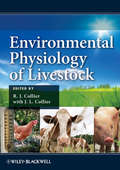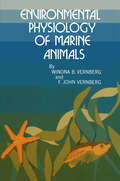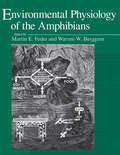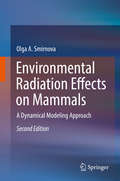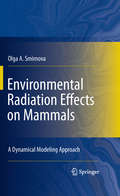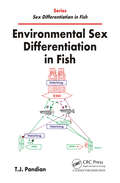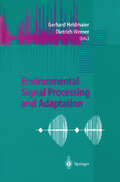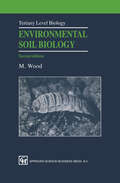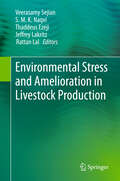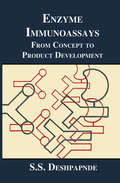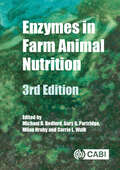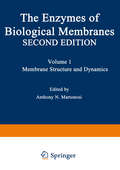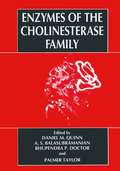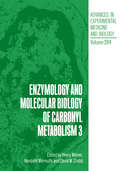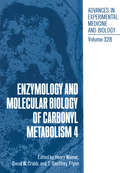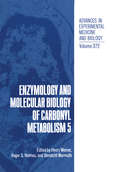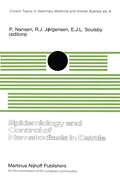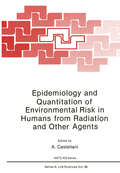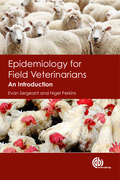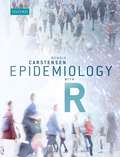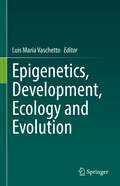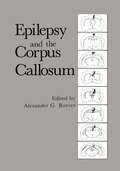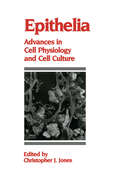- Table View
- List View
Environmental Physiology of Livestock
by R. J. CollierEnvironmental stress is one of the most significant factors affecting livestock performance and health, and it is only expected to increase with effects of global warming. Environmental Physiology of Livestock brings together the latest research on environmental physiology, summarizing progress in the field and providing directions for future research. Recent developments in estimating heat stress loads are discussed, as well as key studies in metabolism, reproduction, and genetic expressions. Environmental Physiology of Livestock begins with a survey of current heat indexing tools, highlighting recent discoveries in animal physiology, changes in productivity levels, and new technologies available to better estimate stress response. Using this synopsis as a point of orientation, later chapters hone in on major effects of heat stress, including changing metabolic pathways and nutrient requirements, endocrine regulation of acclimation to environmental stress, and reduced reproductive performance. The text concludes with a thorough discussion of environmental effects on gene expressions, providing important insight for future breeding practices. Environmental Physiology of Livestock is a globally contributed volume and a key resource for animal science researchers, geneticists, and breeders.
Environmental Physiology of Livestock
by R. J. Collier J. L. CollierEnvironmental stress is one of the most significant factors affecting livestock performance and health, and it is only expected to increase with effects of global warming. Environmental Physiology of Livestock brings together the latest research on environmental physiology, summarizing progress in the field and providing directions for future research. Recent developments in estimating heat stress loads are discussed, as well as key studies in metabolism, reproduction, and genetic expressions. Environmental Physiology of Livestock begins with a survey of current heat indexing tools, highlighting recent discoveries in animal physiology, changes in productivity levels, and new technologies available to better estimate stress response. Using this synopsis as a point of orientation, later chapters hone in on major effects of heat stress, including changing metabolic pathways and nutrient requirements, endocrine regulation of acclimation to environmental stress, and reduced reproductive performance. The text concludes with a thorough discussion of environmental effects on gene expressions, providing important insight for future breeding practices. Environmental Physiology of Livestock is a globally contributed volume and a key resource for animal science researchers, geneticists, and breeders.
Environmental Physiology of Marine Animals
by W. B. Vernberg F. J. VernbergWithin recent years man has become increasingly aware of the disastrous environmental changes that he has introduced, and therefore society is now more concerned about understanding the adaptations organisms have evolved in order to survive and flourish in their environment. Because much of the information pertaining to this subject is scattered in various journals or special symposia proceedings, our purpose in writing this book is to bring together in a college-and graduate-student text the principal concepts of the environmental physiology of the animals that inhabit one of the major realms of the earth, the sea. Our book is not meant to be a definitive treatise on the physiological adap tation of the animals that inhabit the marine environment. Instead, we have tried to highlight some of the physiological mechanisms through which these animals have been able to meet the challenges of their environment. We have not written this book for anyone particular scientific discipline; rather, we hope that it will have an interdisciplinary appeal. It is meant to be both a reference text and a text for teaching senior undergraduate and graduate courses in marine biology, physiological ecology of marine animals, and envi ronmental physiology of marine animals.
Environmental Physiology of the Amphibians
by Martin E. Feder Warren W. BurggrenThrough its emphasis on recent research, its many summary tables, and its bibliography of more than 4,000 entries, this first modern, synthetic treatment of comparative amphibian environmental physiology emerges as the definitive reference for the field. Forty internationally respected experts review the primary data, examine current research trends, and identify productive avenues for future research.
Environmental Radiation Effects on Mammals: A Dynamical Modeling Approach
by Olga A. SmirnovaDr. Smirnova's updated text is devoted to the theoretical studies of radiation effects on mammals. It summarizes 35 years of results the author obtained from analyzing dose rate equivalents for the Galactic Cosmic Rays (GCR) and for Solar Particles Events (SPE). This edition also includes two new chapters on skin epidermal epithelium and risk assessment for myeloid leukemia, as well as extended revisions addressing the radiation effects on the blood-forming system. Mathematical models are used to explain the effects of both acute and chronic irradiation on the dynamics of vital body systems, like the hematopoietic system, the development of autoimmune diseases, and the mortality dynamics in homogeneous and nonhomogeneous mammalian populations. The proposed methodology of these studies, the models themselves, and the obtained results are of a great theoretical significance and can find wide practical use.
Environmental Radiation Effects on Mammals: A Dynamical Modeling Approach
by Olga A. SmirnovaThemonographisdevotedtothetheoreticalstudiesofradiationeffectsonmammals. It summarizes the results obtained by the author over the past 30 years, most of them being of high priority. In the course of these studies, a single approach to the modeling of radiation effects on mammals has been elaborated. Speci?cally, in the framework of the developed deterministic mathematical models, the effects of both acute and chronic irradiation in a wide range of doses and dose rates on vital body systems (hematopoiesis, small intestine, and humoral immunity), as well as on the development of autoimmune diseases, are investigated. The radiation effects on the mortality dynamics in homogeneous and nonhomogeneous(in radiosensitivity) mammalian populations are also studied by making use of the developed stochastic models. The most appealing feature of these mortality models consists of the fact that they account for the intrinsic properties of the exposed organism. Namely, within these models the stochastic biometrical functions are calculated proceeding from statistical characteristics and dynamics of the respective critical body system (hematopoiesis or small intestine). The performed theoretical investigations contribute to the development of the system and quantitative approaches in radiation biology and ecology. These studies elucidate the major regulatory mechanisms of the damage and recovery processes running in the vital body systems of exposed mammals and reveal the key par- eters characterizing the processes.
Environmental Sex Differentiation in Fish
by T. J. PandianFish constitute an important natural renewable resource and any reduction in their ability to propagate as a result of human interference may have significant socioeconomic consequences. The negative effect of human activity on sex differentiation and reproductive output in fish is so diverse that it has been difficult to encompass it in a single b
Environmental Signal Processing and Adaptation
by DietrichWerner GerhardHeldmaierAnimals and plants live in changing environmental conditions which require adaptation in order to cope with this. Some of these environmental changes serve as signals which have to be "sensed" and interpreted correctly by the organisms to initiate the adaptation. This signal processing is based on biochemical, molecular and neuronal processes which are discussed in this book. All examples given underline that continuous adjustment of physiological functions is an essential requirement for life and survival in complex changing environments.
Environmental Soil Biology (Experimental and Clinical Neuroscience)
by M. WoodEnvironmental considerations are playing an increasingly important role in determining management strategies for soil and land. Many important environmental issues involve aspects of the biology of soil, and these issues cannot be considered satisfactorily in isolation from a general understanding of soil biology as a whole. This is the second edition of a book first published in 1989 and now thoroughly rewritten to focus on soil ecology and environmental issues. The first part of the book provides an introduction to soils, its inhabitants, and their activities. The second part covers the influence of man on the natural cycles of soil. Topics such as acid rain and nitrogen fertilizers are considered alongside pesticides and genetically modified organisms. A new final chapter has been added which considers how, as we move towards the next millennium, we can apply the concept of sustainability to issues such as global climate change and farming systems. The book is directed at advanced undergraduate and immediate postgraduate students in environmental science and soil ecology, with students of physical geography and earth sciences as an important secondary market.
Environmental Stress and Amelioration in Livestock Production
by Veerasamy Sejian, S.M.K. Naqvi, Thaddeus Ezeji, Jeffrey Lakritz and Rattan LalGiven the importance of livestock to the global economy, there is a substantial need for world-class reference material on the sustainable management of livestock in diverse eco-regions. With uncertain climates involving unpredictable extreme events (e.g., heat, drought, infectious disease), environmental stresses are becoming the most crucial factors affecting livestock productivity. By systematically and comprehensively addressing all aspects of environmental stresses and livestock productivity, this volume is a useful tool for understanding the various intricacies of stress physiology. With information and case studies collected and analyzed by professionals working in diversified ecological zones, this book explores the influence of the environment on livestock production across global biomes. The challenges the livestock industry faces in maintaining the delicate balance between animal welfare and production are also highlighted.
Enzyme Induction (Basic Life Sciences #6)
by Dennis ParkeOur present concepts ofthe regulation of enzyme activity in the cell have been largely based on the extensive body of work which has been carried out with micro-organisms. A distinction between constitutive and adaptive enzymes had already been made well before World War II and work on enzyme adaptation, both in yeast and bacteria, was done by several workers, especially Marjorie Stephenson and her group in Cambridge in the 1930s. In studies starting about 1947 Stanier demonstrated that the oxidation of aromatic compounds by species of Pseudomonas involved the coordinate and sequential induction of a group of enzymes concerned in the orderly catabolism of a substrate which acted as the inducer. The investigations of Umbarger and of Pardee, both in 1956, established the principle, which is now firmly established for almost all anabolic reaction chains, that the first 'committed' step in a biosynthetic pathway is sensitive to feedback control by the final product of the particular reaction sequence. This control can be exercised in two ways. It can either act on the rate of formation of the enzyme or it can affect the activity of the latter without altering the concentration of the enzyme.
Enzymes in Farm Animal Nutrition
by Ceinwen Evans Hamish Irving Jari Vehmanperä Kari Juntunen John Patience Qingyun Li Amy Petry Jason Lee Kyle Brown Aaron Cowieson Daniel Menezes-Blackburn Ralf Greiner Ursula KonietznyFrom alpha-galactosidases to xylanases, Enzymes in Farm Animal Nutrition provides a comprehensive guide to all aspects associated with enzyme-supplemented animal feeds. It details the history and size of the feed enzyme market, before describing how feed enzymes are manufactured and employed in monogastric, aqua and ruminant diets. This new edition explores considerable advances such as the use of enzymes in fish and shrimp diets, new understanding of how phytases function in the animal, NSPase research and enzymes' extended use in ruminant markets. This book also: - Provides comprehensive coverage of all topics relating to the production, use, co-operativity and analysis of feed enzymes. - Is fully updated throughout, revealing significant developments such as new methods to deliver enzymes (formulations, encapsulations, and liquid spray systems) and advances in enzyme analysis. - Includes brand new chapters on combinations of enzymes, antibiotic-free diets and how to measure response in feed-enzyme trials. Covering biochemistry, enzymology and characteristics relevant to animal feed use, this book forms a valuable resource for academics and students of animal nutrition and production, as well as professionals in the animal feed industry.
The Enzymes of Biological Membranes: Volume 1 Membrane Structure and Dynamics
by A. N. MartonosiIn the first edition of The Enzymes of Biological Membranes, published in four volumes in 1976, we collected the mass of widely scattered information on membrane-linked enzymes and metabolic processes up to about 1975. This was a period of transition from the romantic phase of membrane biochemistry, preoccupied with conceptual developments and the general properties of membranes, to an era of mounting interest in the specific properties of membrane-linked enzymes analyzed from the viewpoints of modem enzymology. The level of sophistication in various areas of membrane research varied widely; the structures of cytochrome c and cytochrome b5 were known to atomic detail, while the majority of membrane-linked enzymes had not even been isolated. In the intervening eight years our knowledge of membrane-linked enzymes ex panded beyond the wildest expectations. The purpose of the second edition of The Enzymes of Biological Membranes is to record these developments. The first volume describes the physical and chemical techniques used in the analysis of the structure and dynamics of biological membranes. In the second volume the enzymes and met abolic systems that participate in the biosynthesis of cell and membrane components are discussed. The third and fourth volumes review recent developments in active transport, oxidative phosphorylation and photosynthesis.
Enzymes of the Cholinesterase Family
by A. S. Balasubramanian Bhupendra P. Doctor Daniel M. Quinn Palmer TaylorThe Fifth International Meeting on Cholinesterases convened in Madras, India, in September of 1994. The long and rich history and culture of India provided an excellent setting for the meeting. More than 120 delegates from Asia, Australia, Europe and North America heard 54 oral presentations and viewed 54 posters on current research on enzymes of the cholinesterase family. The aim of this book is to compile the presentations of the Fifth International Meeting on Cholinesterases into a volume that describes recent investigations on the structure and catalytic function of acetylcholinesterase (AChE), butyrylcholinesterase (BuChE) and related enzymes, as well as studies on the molecular and cellular biology of these enzymes and the genes which encode them. Cholinesterases enjoy a long and storied history in diverse areas. In basic biochemical research, AChE is one of the best studied, though yet enigmatic, of enzymes. The efficient catalytic function of this enzyme presents the biochemist with a fundamental challenge in understanding the relationship between structure and function. AChE and BuChE belong to a family of proteins, the alB hydrolase fold family, whose constituents evolutionarily diverged from a common ancestor. Proteins in this family have a wide range of physiological functions. In commerce, AChE is a prime target for agricultural insect control, and for the development of therapeutic agents for Alzheimer's disease.
Enzymology and Molecular Biology of Carbonyl Metabolism 3 (Advances in Experimental Medicine and Biology #284)
by David W. Crabb Henry Weiner Bendicht WermuthThe Fifth International Workshop on the Enzymology and Molecular Biology of Carbonyl Metabolism was held at Purdue University in June, 1990. This represents the fifth time that I had the privilege of organizing the scientific program. It was the first time that I actually hosted the meeting. I wish to salute my four previous co-organizers and the thousands of scientists who have hosted other meetings. It is much easier to arrange the scientific program and edit the proceedings. No local organization could occur without the help of ones research group and, in this case, my wife. I sincerely thank Esther and my research group for their advise and help. At this Workshop, similar to the preceeding ones, much new information was presented. It was apparent how molecular biological techniques were influencing the direction of the research on the three families of enzymes discussed. It also was apparent that not all biochemical problems could be solved by using these techniques. Many of the presentations showed how important advances still could be made using more traditional biochemical approaches.
Enzymology and Molecular Biology of Carbonyl Metabolism 4 (Advances in Experimental Medicine and Biology #328)
by Henry Weiner David W. Crabb T. Geoffrey FlynnThe Sixth International Workshop on the Enzymology and Molecular Biology of Carbonyl Metabolism was held outside of Dublin, Ireland at the end of June, 1992. Prof. Keith Tipton, Chairman of the Biochemistry Department at Trinity College, kindly agreed to host the meeting. On behalf of all of us who attended I wish to extend our sincere thanks to the whole Tipton family for making us feel so welcome in Ireland. It has been a decade since the frrst workshop was held in Bern, Switzerland. The scope of the meetings reflected somewhat the changes that have occurred in biochemistry during the past decade. At the first meeting primarily enzymes and their properties were discussed. At this last meeting many of the talks centered on gene regulation as well as more traditional aspects of enzymology and metabolism. During the past decade site directed mutagenesis to probe for the active site of an enzyme has become part of traditional enzymology; this was virtually unheard of at our frrst meeting. Many of the presenters now used this tool to study some aspect of structure and function of one of the three carbonyl metabolizing enzymes.
Enzymology and Molecular Biology of Carbonyl Metabolism 5 (Advances in Experimental Medicine and Biology #372)
by Henry Weiner Roger S. Holmes Bendicht WermuthSince the inception of these meetings in 1982, they have always been a satellite of the International Society for Biomedical Research on Alcoholism meeting. At our 1992 meeting in Dublin we learned that the next ISBRA meeting would be held in Brisbane, of all our previous meetings, I was very concerned Australia. As the scientific organizer about holding a meeting in the Southern Hemisphere for fear that many of our potential participants would not travel that far. I am pleased to say that I was proven to be incorrect. Nearly 90 scientists from a dozen countries participated at our seventh conference. At this meeting, like at all our previous ones, much new information about the three enzyme systems was presented. Of equal importance was, like at all our previous meetings, the extreme openness of the participants to discuss ideas, future directions and unpublished data. On behalf of all the participants I wish to express our sincere thanks to our Massey University colleagues for the excellent organization of this Palmerston North, New Zealand meeting. These included Kathryn Kitson, Michael Hardman, Paul Buckley, Trevor Kitson and Len Blackwell. At this meeting a few new innovations were introduced. Though posters are common at many meetings, bush walks and visits to nature preserves to see kiwi birds Our hosts were able to secure support from the International Union of Biochemistry are not.
Epidemiology and Control of Nematodiasis in Cattle: An Animal Pathology in the CEC Programme of Coordination of Agricultural Research, held at the Royal Veterinary and Agricultural University, Copenhagen, Denmark, February 4–6, 1980 (Current Topics in Veterinary Medicine #9)
by E. J. L.Soulsby R. JessJørgensen P. NansenThis publication is the Proceedings of a workshop held at the Royal Veterinary and Agricultural University in Copenhagen, Denmark on 4th - 6th February, 1980, sponsored by the Commission of the EUropean Communities (CEO) as a part of the programme of coordination of agricultural research in the field of animal pathology. The CEO wishes to thank those who took responsibility for the organisation of the workshop, those who presented the papers, and all participants. VII CONTENTS SESSION I METHODOLOGY I MONITORING PASTURE INFECTIVITY AND PASTURE CONTAMINATION WITH INFECTIVE STAGES OF Dictyocaulus viviparus 3 R. J. J¢rgensen THE CORRECT HANDLING OF FAECAL SAMPLES USED FOR EXAMINATION OF Dictyocaulus viviparus LARVAE 11 H. J. W. M. Cremers SOME EFFECTS OF STORAGE ON THE RECOVERY OF Dictyocaulus viviparus LARVAE FROM FAECES 17 M. T. Fox EXPERIENCES WITH OUR TECHNIQUES FOR THE RECOVERY OF NEMATODE LARVAE FROM HERBAGE H. -J. Burger 25 A TECHNIQUE FOR THE RECOVERY OF INFECTIVE TRICHOSTRONGYLE LARVAE FROM SOIL 31 K. Bairden, J. L. Duncan and J. Armour SESSION I METHODOLOGY II A MODIFIED AND SIMPLE MCMASTER TECHNIQUE 45 Sv. Aa. Henriksen COMPARISON OF TECHNIQUES FOR ASSESSMENT OF THE CONTAMINATION OF PASTURE HERBAGE WITH INFECTIVE NEMATODE LARVAE 51 J. -P. Raynaud and L. Gruner RECOVERY OF Ostertagia FROM THE BOVINE ABOMASAL MUCOSA BY IMMERSION IN WARM NORMAL SALINE 69 N. E. Downey CONTROLLED/CRITICAL TESTS IN THE EVALUATION OF ANTHELMINTIC ACTIVITY 75 D. D{;.
Epidemiology and Quantitation of Environmental Risk in Humans from Radiation and Other Agents (Nato ASI Subseries A: #96)
by A. CastellaniThe identification and quantitation of environmental risk in humans is one of the main problems to be solved in order to improve the protection of individuals and of human populations against phys ical and chemical pollutants. Epidemiology plays a central role in the evaluation of health risk directly in human populations. In this volume are collected 33 lectures presented at the AS! course on "Epidemiology and quanti tat ion of environmental risk in humans from radiation and other agents: potential and limitations", sponsored by NATO and Italian Association of Radiobiology and or ganized by ENEA. The course has been devoted to a number of aspects of environ mental risk analysis and evaluation based on epidemiological in vestigation. Basic epidemiological concepts and methods have been reviewed. Fundamentals of dosimetry and microdosimetry were presented in re lation to the contribution of epidemiology in defining the dose effect relationships for radiation carcinogenesis and its relation with age, sex and ethnicity. The mechanisms of carcinogenesis as a multi-stage process were illustrated. One of the main topics was 'cancer epidemiology' and its cor relation with: - occupational and non-occupational exposure to ra diation - diagnostic and therapeutic irradiation - cancer proneness - hereditary and familiar diseases - abnormal response to carcino gens - environmental pollution in air and water - exposure to radon in mines and in building material - atomic bomb explosion - chemo therapy - dioxin and related compounds.
Epidemiology for Field Veterinarians: An Introduction
by Evan Sergeant Nigel PerkinsIntended as an introduction for veterinarians and other animal health professionals interested in and wishing to apply epidemiological methods in their day-to-day work, this book provides a practical guide for those new to the field. Its applied focus covers the principles of epidemiology in real world situations and practical implementation of disease outbreak investigation, for both emerging and endemic diseases. Techniques and methods are discussed, supported by case studies and practical examples to illustrate their application. The book is clearly written and accessible, providing readers with practical information and encouraging the development of problem-solving skills. It is an essential handbook for veterinary surgeons and students and those involved in animal health, food safety and epidemiology.
Epidemiology with R
by Bendix CarstensenThis practical guide is designed for students and researchers with an existing knowledge of R who wish to learn how to apply it in an epidemiological context and exploit its versatility. It also serves as a broader introduction to the quantitative aspects of modern practical epidemiology. The standard tools used in epidemiology are described and the practical use of R for these is clearly explained and laid out. R code examples, many with output, are embedded throughout the text. The entire code is also available on the companion website so that readers can reproduce all the results and graphs featured in the book. Epidemiology with R is an advanced textbook suitable for senior undergraduate and graduate students, professional researchers, and practitioners in the fields of human and non-human epidemiology, public health, veterinary science, and biostatistics.
Epigenetics, Development, Ecology and Evolution
by Luis María VaschettoEpigenetic modifications comprise heritable gene expression changes that occur without alteration of the DNA sequence and 'co-act' with genetic factors to shape development processes and evolutionary trajectories. Multicellular organisms receive different types of environmental stimuli/stresses that trigger epigenetic modifications during development. These environmentally driven mechanisms represent an underlying cause of phenotypic diversity, especially in metazoans. This book aims to present some of the latest epigenetic insights into the development of metazoans (including humans) as an intersection between their ecology and evolution.
Epilepsy and the Corpus Callosum
by Alexander G. ReevesInJuly 1982 the first Dartmouth workshop on the corpus callosum took place. A nucleus of basic and clinical scientists was convened to give progress reports of their work on the corpus callosum. This text was subsequently compiled by the various participants from these reports modified by a stimulating cross fertilization of ideas and subsequent studies. Four and one-half decades have intervened since Van Wagenen first sectioned the corpus callosum for epilepsy (Van Wagenen and Herren, 1940) and Erickson (1940) demonstrated that the corpus callosum is the major route for generalization of experimentally induced focal cortical epilepsy. During the succeeding 45 years a handful of clinicians has pursued these leads to confirm the therapeutic value of callosotomy for some types of medically intractable generalized epilepsy. Parallel experimental studies with a number of epilepsy models have indicated that the corpus callosum is indeed the major route for seizure generalization, that the brainstem is a secondary and more resistant pathway for seizure generalization, and that most if not all epileptic seizures originate from the cerbral cortex. The unexpected clinical finding that even partial (focal) seizure incidence is modified by callosotomy now has been demonstrated in the laboratory. The various contributors to the clinical and experimental epilepsy sections of this volume have been seminal in these elucidations, as will be evident from their chapters. The section on the development, anatomy, and physiology of the corpus callosum demonstrates that these basic areas of study have not been neglected.
Epithelia: Advances in Cell Physiology and Cell Culture
by C. J. JonesEpithelial cells probably constitute the most diverse group of cells found in the body. In addition to serving as interfaces between external and internal environments, their functions include ion and fluid secretion and reabsorp tion, protein exocytosis, hormone secretion, recognition, surface protection and the control of ciliary movement. By their very exposure on the surfaces of the body, epithelial cells are subjected to wide-ranging assault, by micro organisms and by chemical and physical forces. They are the targets for abrasion, infection and malignant transformation. Some epithelial cells show altered behaviour in inherited syndromes, such as cystic fibrosis, characterized by serious pancreatic and pulmonary disease. In view of the importance of epithelia and the fact that their function can be altered by environmental and inherited factors, they are the subject of intensive research, particularly so in the case of cancer where most tumours are of epithelial origin. The use of animal tissues in epithelial research continues to provide important advances and this, coupled with the need to focus more on human tissues, has prompted a greater research emphasis on accessible human epithelia and on the establishment of cell cultures from animal and human sources. For primary cell cultures and cell lines to be of value, they need to express properties appropriate to their progenitors and relevant to the study in progress.
